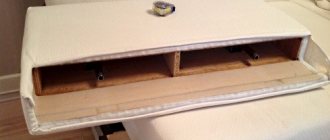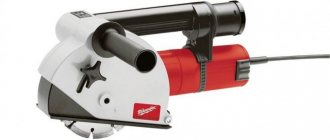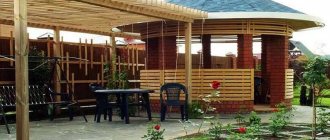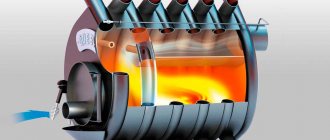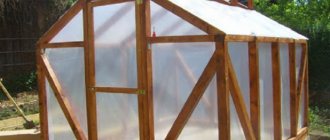The construction of greenhouses and sheds, the laying of utilities - all this requires a bent metal profile. But buying pipes bent to order is expensive, and purchasing a ready-made pipe bender is also not a cheap pleasure. So modern craftsmen use devices and self-made mechanisms to create metal arcs of the required radius.
In this article we will consider the following questions:
- Types of homemade pipe benders and their features.
- The design of the simplest device for bending square pipes.
- Design of a three-roll machine for bending round and square pipes.
- Technology for bending pipes using a three-roll homemade pipe bender.
Why do you need to bend pipes with a pipe bender?
Metal collectors can be bent in a simple mechanical way, having first secured one end of the tube, using gas welding, or other methods.
But in order to give a thin-walled steel or metal-plastic pipe the required shape of the highest quality, it is best to use a homemade pipe bender.
Using this method, the product will bend very well and its structure will be completely preserved.
The use of a pipe bender is due to:
- the least risk of unnecessary pipe deformation;
- ease of use;
- the ability to work with risers of any diameter;
- complete safety when working with the device.
Plus, there is no need to waste time and money heating the product, the number of joints (welded or threaded) is reduced, and the design of the line will be more reliable and impact-resistant.
When installing a pipeline, use a manual, hydraulic or electric pipe bender (ET). Today, the last option, which you can do yourself, is considered the most popular.
Methods for bending pipes using a homemade machine
The question of how to bend a profile pipe using a homemade pipe bender is unlikely to confuse you if you read a few more recommendations. Hydraulic machines can be used to successfully bend profile pipes made of different materials, as well as thick-walled products. This operation can be performed using either a cold or hot method, which involves preheating the pipe section.
Thus, a manual hydraulic bending machine can be used to influence the pipe in two ways:
- cold;
- hot.
Another variation with a jack
Cold bending is the simplest bending method, which is used for pipes made of plastic materials. The subtlety of this process is to fill the pipe before the flexible pipe with sand, salt, oil or cold water. This allows you to get a better bend without significant deformation of the pipe.
If you are interested in the question of how to properly bend a profile pipe with thick walls or made from materials of increased rigidity, then the answer to this question is to use the hot bending method.
When is an electric pipe bender used?
For working with a large number of products
Such a homemade pipe bender can be used to perform not just complex, but also the most important work on the required section of the pipeline.
Important! Using an electric pipe bender, you can bend steel pipes of any diameter and with any wall thickness used in the installation of pipelines, the required bending radius.
Unlike the manual design, which is most often used at home, an electric machine is used to process risers in large quantities.
When laying pipe communications, you often have to deal with structural elements with turns. It is clear that the ideal option in such cases is ready-made devices.
But, firstly, they are not always at hand, and secondly, it happens that standard jumpers cannot always be used for a specific section of the pipeline.
For making connections with precise angles
For example, if it is necessary for a pipe to run at an angle of 90⁰, then using an electric pipe bender you can easily make the necessary connection with your own hands with an accuracy of one degree. The main advantage of such a homemade device: the hands and the frame do not feel any recoil, although its force is equal to the force created by hydraulic equipment. Therefore, the pipe bending machine can be placed on soft surfaces and even shaky bases.
Classification by bending method
Based on the nature of the profile impact, the following types are distinguished:
- Segmental - pulls the workpiece through a series of rollers, each of which has its own effect and changes the geometry.
- Crossbow - its main element is a device that sharply moves forward, bending the fixed rolled product along the required radius.
- Spring - equipped with grips that straighten and bend the structures being held (if they are made of not the most durable material, for example, plastic).
When performing work, say, assembling a frame for a country greenhouse, you should not chase big corners. Remember, the more you deform the part, the more likely it is to break under load.
Well, now let's move on to the features of creating the simplest mechanisms.
Features of the functioning of a homemade electric pipe bender
Thanks to this electric machine, a minimum of effort is applied during operation. The tool is used in the process of carrying out more complex operations with pipes made of any materials that are beyond the strength of hand tools.
Although manual pipe benders are also designed to work with pipes made of various materials, such a tool is most often used to perform small-scale work in the household. To operate an electric pipe bender, you do not need to apply human force, since all the work is done by the hydraulic unit. Manual machines have one connector and are designed for a pipe of a specific diameter. And only individual copies can be used to work with tubes of different sections.
A self-made electric pipe bender is universal, since creating such a unit with which you can process a pipe of the same radius is obvious waste. And it’s true: with such equipment you can quickly and efficiently perform a large amount of work with pipes of different sections. True, the use of such equipment in small facilities is unprofitable due to the high costs of ensuring the operation of the device.
The operation of a self-made electric pipe bender is similar to the principle of operation of a manual device. The difference is that the mechanical drive in the design is replaced by a hydraulic rod, the shafts of which are driven by an electric drive rather than a chain drive.
Important! A homemade electric pipe bender can be used to bend several pipes at the same time. To do this, you need to make special cuts on the rollers.
In addition, you can make an electric pipe bender with your own hands for profile (square, rectangular, diamond-shaped, etc.) pipes. Schemes, drawings, components, the principle of operation is the same as the device for round pipes.
Crossbow type pipe benders
These pipe benders got their name because of their resemblance to a crossbow. The basis of the design of such a device is a frame made by welding from corners and channels. Inside such a frame, on which two movable rollers are mounted, there is a jack, which, using a special shoe, creates a force directed at the pipe. Pipe benders with movable rollers and a pressure shoe are used primarily for bending round pipes, since they can simply deform any other type of product.
A rugged, no-frills crossbow pipe bender
Use of diagrams and drawings
Not everyone knows how to make a pipe bender at home, but many would like to learn how to do it.
Pipe bending device diagram
Before you start making an electric pipe bender with your own hands, you need to calculate everything, familiarize yourself with several drawings, and choose among them, in your opinion, the most suitable one. When a person does not have special education or has never done such things, it is not so easy to make even the simplest equipment on their own. It is clear that it is best to consult with a specialist who already has experience in manufacturing such devices. If such a master is not nearby, it doesn’t matter, since the World Wide Web will come to the rescue. With its help, you can not only familiarize yourself with textual information, but also select diagrams, drawings, and watch a video on how to properly make an electric pipe bender with your own hands. Although, it is advisable not only to watch, but also to download the necessary drawings and videos, which describe step by step the process of manufacturing a device for bending round and profile pipes.
For example, you can use this drawing to make an electric pipe bender, with which you can easily make a device for bending pipes yourself.
Important! When making a device with your own hands, its cost will be significantly lower than a similar factory tool, but the quality will be the same.
Character traits
At its core, this is a mechanical device (installation) that bends a straight profile to the desired radius, from 1 to 180 degrees. Suitable for both metal (aluminium, steel) and plastic elements.
Factory equipment is standard, but it assumes you have experience with it. Therefore, it’s worth making a pipe bender for a professional pipe with your own hands, if only because you don’t have to get used to it. You will know exactly all the features of its design and understand what loads its elements will withstand.
Advantages
An electric pipe bender has a number of advantages compared to manual counterparts.
These include:
- the quality of the bending process, which consists in the fact that the final product has a bend accurate to a degree;
- decent pace of work performed;
- high efficiency of the tool for bending steel, copper, aluminum, metal-plastic and pipes from other materials;
- the ability to configure the optimal operating mode of the equipment.
It is interesting that with the help of such a device the pipe is bent as needed, and not as it turns out. Plus, with such a high quality of products, a minimum of physical effort is expended, which is very important when installing a pipeline network yourself.
How to make a profile pipe bender with your own hands, working according to a template
In this case, the guide elements are boards, the cross-section of which should be a couple of centimeters larger than that of rolled products.
- Securely fasten the selected wooden products to a durable metal base that can withstand even significant loads.
- Place a stop nearby on which the bent parts will subsequently be placed.
- Connect the winch so that you don’t have to make physical efforts when making the passage.
With this version of the device, it is not necessary to saw the boards to create bevels, gutter or slope, and this has a positive effect on the overall durability of the configuration. But limiters are needed in any case - so that the element being processed does not move out. It must be carefully inserted into the gap between the template and the stop, then gently press on its free end, setting the initial clamping force.
This option is good for its ease of implementation, but it does not always guarantee the accuracy of the curvature - the final radius may be several degrees less than required. Well, the guides are not universal - in fact, they are only suitable for one diameter. Therefore, it makes sense to look for other solutions.
“Snail”: we’ll make this rolling pipe bender with our own hands, with a drawing and diagrams
So named because of the specific shape of the spiral.
This machine is good for stamping large quantities of the same type of blanks. Even in the rack version, its dimensions are relatively small, so placing it on site is not a problem (even if it is a small home workshop). It's also easy to operate. Manufacturing takes place in several stages:
- You make the center - cut off a piece of round timber with a diameter of 38 mm and a thickness of 28 mm, and drill an eccentric hole of 8 mm in it. Using a grinder, remove excess metal to form a voluminous petal. After that, punch out a new seat on its radial surface - for an M10 thread.
- You form a spiral - from a steel strip 4 mm thick, according to the design, with such a shape of turns that you can subsequently provide any desired radius of curvature.
- Cut out the support plate - from a carbide sheet, 3 mm, not narrower, since it must withstand significant loads. Weld it to it.
- Attach the resulting functional unit to a metal stand that is strong enough, with a wall thickness of 3 mm or more. Fix it with bolts screwed into pre-drilled holes for this purpose.
- Weld the handle - on the reverse side, so that in the future it will be easier for you to remove and install the parts being processed.
The only disadvantage of the resulting mechanism is that it provides only small radii of curvature. If you try to greatly bend the workpiece on it, there is a chance that you will simply break it off.
Rental devices
At their core, these are also simple machines that create flexible pipes at any desired angle.
Their peculiarity is that the profile completely passes through their entire structure (hence the name). Otherwise, they do not differ from the standard ones: there is a base and shafts, with the driving ones providing broaching, and the movable one providing pressing force. And then, by the way, it’s time to look at what such equipment generally consists of.
Basic principles of structural assembly
Recommendations for assembly
When assembling equipment, you should adhere to these recommendations.
To make the base, it is best to take a profile rectangular thick-walled pipe (3-4 mm thick) or a corresponding square. At a distance of 3 cm from the end, it is necessary to make a hole through it, the cross-section of which would coincide with the diameter of the axis inserted into it. It is best to start installation by installing the control lever, along with the pulley, and the stationary pulley.
Using a hacksaw for metal, cut off the excess profiles, remembering that the amount of trimming is affected by the maximum bending angle that we plan to obtain during bending.
You can make the lever and axle for the pulley yourself. To do this, you need to take 2 steel plates (thickness - 5 mm, and width - must correspond to the required diameter of the axis), fold them, put on a steel tube that will serve as a jumper and weld everything.
Important!
It is better to use cotter pins for fastening rather than welding, since there should be minimal play of individual parts of the device during bending, which is impossible with welded parts of the tool. Main stages
First, you need to install the feed shaft on the tool frame, and attach the pulley to the end of it. It is connected to the engine rotor using a belt drive. The drive sprocket should be fixed at the second end to carry out transmission using a chain.
Install the second shaft on the frame of the structure, which should also be equipped with a driven sprocket at the end.
Place the latch pin and screw in the latch.
An option is possible when deforming rollers (upper and lower) are installed at the top and bottom of the structure. It is advisable to install a third roller at the bottom of the equipment, but this procedure will entail the necessary cutting of a hole in the frame.
The grooves of trapezoidal plates are used to position the deformation roller shaft. You can also use a U-shaped fork to place it, the legs of which are welded to the side of the device frame. Moreover, when the roller moves along the grooves, on the one hand its movement is limited by the piston rod, and on the other by the deformable pipe.
Important! When installing shafts, it is possible to use not only standard cups with bearings, but also the use of trapezoidal plates that are welded to the side of the frame. In this case, it is necessary to replace the shafts with rope rollers.
That's all, the homemade manual pipe bender is ready. But after that it must be connected to an electric drive, then it will become an electric tool. The entire process of assembling the structure can be seen in full and in sufficient detail in the video.
Advantages and disadvantages of manual pipe benders
These are relatively compact devices that have a certain degree of mobility even in the amateur version. They do not have heavy or large components, so they can be easily transported or even moved to another site. Due to their simple design, they are reliable and durable. They do not require a network connection and do not waste electricity. This is their undeniable advantage.
On the other hand, they do not cope well with thick metal walls or large diameters, and when working with them, significant physical effort must be applied. Therefore, they cannot provide high labor productivity. Yes, to solve one-time problems, for example, to update the frame of a greenhouse or gazebo at the start of the summer season, you can make a homemade manual pipe bender for a profile pipe with your own hands. But if you spend whole days in your personal workshop, then it’s better to spend money and make an electric or hydraulic model, since there’s nothing complicated in their design either.
Operating principle
The main element of any electric pipe bender is the motor, which must be well tuned, since it is it that provides a gradual rotational load on the product. To do this, you need to install a special attachment on its rotor, which can be of various shapes.
In addition, the design provides for the presence of:
- special clamping mechanisms, which, if necessary, can protect the operator of the machine from possible injuries. With their help, bendable products are also securely fixed in the device;
- protective housing;
- control panel;
- a set of fasteners with the help of which the bent pipe is fastened and, necessary for work, placed.
Classification by drive type
The motor is equipped with quite powerful models, which, in the factory version, are actively used in production. But such equipment can also be assembled personally (based on drawings and diagrams) for subsequent use in a home workshop. Essentially, you will get a machine that looks like this:
- Hydraulic – stationary, powerful, designed for diameters from 3 inches. It is best suited for industrial facilities, as it allows for large-scale work to be carried out with a high degree of productivity.
- Electromechanical is a good choice for bending main elements. It is convenient because it can be used to calculate with maximum accuracy both the optimal clamping force and the required angle.
- Manual – focused on small sections and low intensity of use.
Determining the allowable bend radius
Depending on the material, diameter and wall thickness, the minimum bend radius is determined, which can be found using the data in the following table (for steel pipes:
| Diameter, mm | Min value of bending radius, mm | |
| Wall thickness ≤2mm | Wall thickness ≥2mm | |
| From 5 to 20 | 4 diameters | 3 diameters |
| From 20 to 35 | 5 diameters | 3 diameters |
| From 35 to 60 | — | 4 diameters |
Video
What types of profile pipes are there?
When talking about profile pipes, we mainly mean square, oval or rectangular products. As for the production method, they can be suture or seamless, with or without tempering. Tempering is a special procedure that results in the removal of internal stresses after the profile has been formed.
In general, we can say that the range of profile pipes is so diverse that several GOSTs were required to standardize it. For example, square-type profile pipes are determined by GOST 8639-82.
These regulatory documents contain instructions on the parameters by which thin-walled and thick-walled profile pipes are manufactured. The upper overall feature for them is the size of 180x180 mm, with a wall thickness of 8-14 mm. The smallest profile pipe is a square product of millimeter thickness, with a side size of 10 mm. From these values, the technology by which this rolled product is subjected to longitudinal deformation was determined.
A hollow beam measuring 18x18 cm, where the wall thickness reaches 1.5 cm, can only be bent using special equipment.
Reinforcement bending - process features
At any construction site today you can see various equipment, many tools and devices, and almost every one of them has a machine for bending reinforcement. This is no coincidence: the most effective technology for strengthening fragile concrete structures, protecting them from destructive loads in compression, tension and bending, is reinforcement, which is performed using metal rods - reinforcement. Without a high-quality reinforcement frame, it is almost impossible to build reliable concrete walls and foundations.
Professional equipment capable of bending reinforcement of a very decent diameter looks like this.
It would seem much easier to reinforce corner concrete structures and adjacent wall areas using straight reinforcing bars. However, in this case, the concrete structure will be greatly weakened and may delaminate. In addition, this is a gross violation of building codes. In any corner concrete structures, it is necessary to use only bending, with an overlap of at least 80 cm on each side. A machine or a simple device for bending metal rods is also useful if you need to quickly produce connecting elements of various types - hooks, claws, etc.
And this is a simple homemade solution, mounted on a floor slab right on the construction site.
When bending steel bars used for reinforcement, it is very important to know how to bend foundation reinforcement so that it does not lose its strength characteristics. To comply with this requirement, it is necessary to perform such an operation only mechanically, using special machines for cutting and bending reinforcement. In this case, it is important to ensure that the bend angle is not sharp, and that the radius of curvature at the bend is from 10 to 15 diameters of the rod itself. It should be remembered that a steel reinforcing bar bends without losing its strength characteristics up to an angle of 90 degrees, then the strength indicators begin to decrease.
If you don’t have the time or desire to deal with homemade products, then purchasing a similar ready-made bender would be a good way out.
When bending steel reinforcing bars with your own hands, two mistakes are often made:
- a notch is made at the bend site using a grinder or other tool;
- The section of the reinforcement where the bend will be located is heated using a gas burner or blowtorch.
After such procedures are completed, some primitive means for bending is used: a heavy hammer, a sledgehammer, a piece of pipe, a vice, etc. These bending methods lead to a significant weakening of the reinforcement, which can cause the destruction of concrete structures. In such cases, you should always remember that you need to bend the reinforcing bars without violating their integrity and only if they are in a cold state.
In general, everything here is expensive and serious - full automation and many settings. For home craftsmen, this video is provided for informational purposes only. Since spending 130-180 thousand rubles on such a unit for non-professional use does not make any sense.
